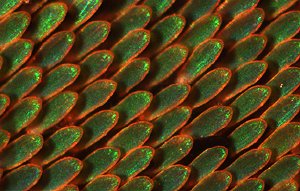Jun 14 2010
At the very heart of some of the most brilliant colors on the wings of butterflies lie bizarre structures, a multidisciplinary team of Yale researchers has found. These structures are intriguing the team's scientists and engineers, who want to use them to harness the power of light.
 The vivid green color of the scales of this Papilionid butterfly are produced by optically efficient single gyroid photonic crystals.
The vivid green color of the scales of this Papilionid butterfly are produced by optically efficient single gyroid photonic crystals.
The crystal nanostructures that ultimately give butterflies their color are called gryoids. These are “mind-bendingly weird” three-dimensional curving structures that selectively scatter light, said Richard Prum, chair and the William Robertson Coe Professor in the Department of Ornithology, Ecology and Evolutionary Biology. Prum led the Yale team, which reported its findings online in the Proceedings of the National Academy of Sciences.
Prum over the years became fascinated with the properties of the colors on butterfly wings and enlisted researchers to help study them from the Departments of Chemical Engineering, Physics and Mechanical Engineering, as well as the Yale School of Engineering and Applied Science.
Using an X-ray scattering technique at the Argonne National Laboratory in Illinois, Richard Prum, his graduate student Vinod Saranathan and their colleagues determined the three-dimensional internal structure of scales in the wings of five butterfly species.
The gyroid is made of chitin, the tough starchy material that forms the exterior of insects and crustaceans, Chitin is usually deposited on the outer membranes of cells. The Yale team wanted to know how a cell can sculpt itself into this extraordinary form, which resembles a network of three-bladed boomerangs. They found that, essentially, the outer membranes of the butterfly wing scale cells grow and fold into the interior of the cells. The membranes then form a double gyroid — or two, mirror-image networks shaped by the outer and inner cell membranes. The latter are easier to grow but are not as good at scattering light. Chitin is then deposited in the outer gyroid to create a single solid crystal. The cell then dies, leaving behind the crystal nanostructures on the butterfly wing.
Photonic engineers are using gyroid shapes to try to create more efficient solar cells and, by mimicking nature, may be able to produce more efficient optical devices as well, Prum said.